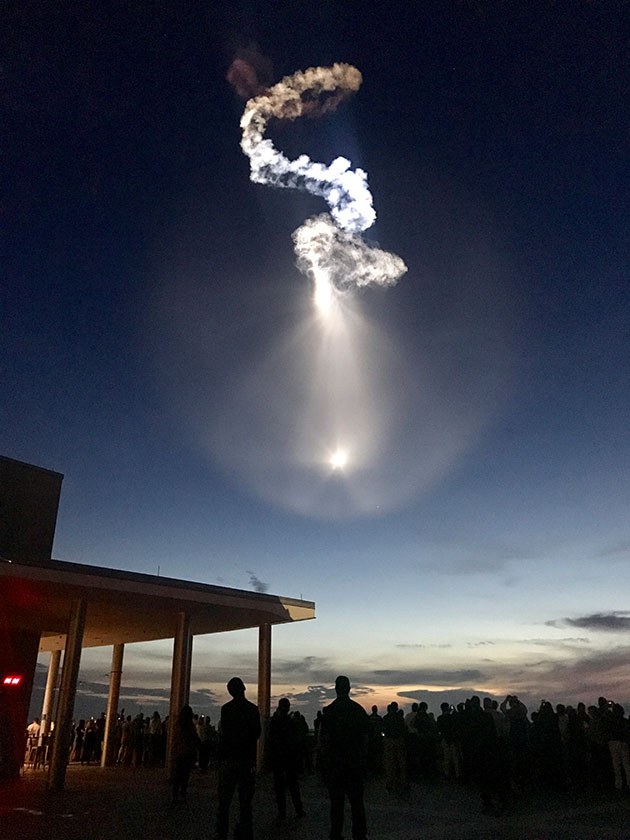CIMON – when science fiction becomes reality

Cape Canaveral, Florida – it is really thrilling – go CIMON, go! Accompanied by a thunderous roar, the SpaceX Falcon 9 launcher slowly rises from the launch pad above a dazzling stream of fire, delivering 7600 kilonewtons of thrust to thwart gravity painting a spectacular picture against the early morning skies over Florida. This 'dragon's tail' was even visible from the ISS itself. It takes the Dragon capsule for the SpaceX CRS-15 (Commercial Resupply Service) mission three days to arrive at the International Space Station (ISS), carrying a payload of precisely 2676 kilograms (provisions, equipment and scientific experiments) in the 'dragon's body'. What made this supply flight to the ISS so special was that it included a whole series of German experiments for Alexander Gerst's 'horizons' mission. Among them was CIMON (Crew Interactive Mobile Companion).
We are making history as pioneers in the use of artificial intelligence. CIMON is a building block in the future of human spaceflight.
Equipped with artificial intelligence (AI) from IBM, CIMON is an astronaut assistance system developed by the DLR Space Administration in Bonn together with Airbus. Measuring 32 centimetres in diameter and weighing five kilograms, CIMON defines a new global benchmark and pushes the boundaries of technical feasibility. This intelligent astronaut assistant is far more than just a 'space smartphone'. CIMON can see, hear, understand, speak – and fly. It is an initial technology demonstrator that Alexander Gerst will test during his work on the 'horizons' mission. In the medium term, CIMON will also assist other astronauts operating in the microgravity environment of the ISS. Voice-controlled document access is one of the major advantages of CIMON, because astronauts can keep both hands free for their work. As the DLR project manager in charge of CIMON, I witnessed the SpaceX lift-off live on the ground at the Kennedy Space Center. This was a moment of profound humility. Creating CIMON was a herculean task for everyone involved – two years of hard work that had finally culminated in a moment of overwhelming joy. The launch itself seemed almost surreal, and all of the tension I had previously felt just melted away. Go CIMON, go!

On the previous day, I had spoken about CIMON at an official NASA press conference marking the launch of SpaceX CRS-15. It was a great honour for me, and I was really excited. We can write a piece of history if CIMON works as planned on the ISS. We would be pioneers in the use of artificial intelligence in space. The worldwide media attention that greeted CIMON as the first AI application in space exceeded all of our expectations. Together with my colleagues from Airbus and IBM, I was literally swamped with interview requests.

A few weeks earlier, I had travelled to Baikonur in Kazakhstan to attend the launch of the Soyuz spacecraft taking Alexander Gerst to the ISS. These two launches within just one month (Soyuz and Falcon-9) were a stark contrast for me. Two places that could hardly be more different both act as portals to space. Nevertheless, they share a common dedication to humanity's greatest project – the ISS. The ISS is more than just an object flying 400 kilometres above our heads, moving at a rate of 28,000 kilometres per hour. For me, this 'international residential community' is living testimony to international understanding. More than 100,000 people around the world have worked on the project. The most astonishing thing – the ISS was built in a number of countries, but only assembled out in space. I see this international collaboration as a kind of cosmic 'science picnic'. Everyone brings the things they are best at, and only in this way does it become a truly magnificent event for everyone. Together, they achieve what none of them alone would ever have managed. The privilege of being involved in and making a contribution to this human accomplishment of peaceful collaboration engenders deep gratitude in me and profound awe. Here, all of the participating nations act as a big 'space family' that is built on cooperation and mutual support.
In my dream job as a manager for human spaceflight, I am driven consistently by my enthusiasm for and fascination with space. Each day I am confronted with countless emails, calls, meetings, contractual matters, technical documents, press enquiries and much more. In doing so, I come into contact with all kinds of people: engineers, software developers, scientists, media representatives, lawyers, business managers, and also astronauts. CIMON was implemented as a 'fast-track' project. In most cases, a similarly complex venture in the space sector would require around five to 10 years to complete, but together with Airbus, IBM, LMU Munich, BIOTESC and ESA, we managed it in less than two. This fills us with great pride. It was an arduous, rocky path, and often we faced serious challenges. But we continued nonetheless and never even considered giving up, true to the space motto: "Failure is not an option!"

So I was able to experience two rocket launches in just one month, namely Soyuz with Alexander Gerst and SpaceX CRS-15 with CIMON. But I can top even that (#dreamjob), as in March of this year I hitched a ride with CIMON on a parabolic flight and experienced 21 seconds of microgravity 31 times. It was an incredible experience, about which I would actually have to write a separate blog article. Here is a teaser – the main purpose of the parabolic flight was to test CIMON's orientation, navigation and control to prepare it for use in the permanent microgravity environment on the ISS.
And yes, I enjoy going to work every day – even on Mondays.
Tags:
